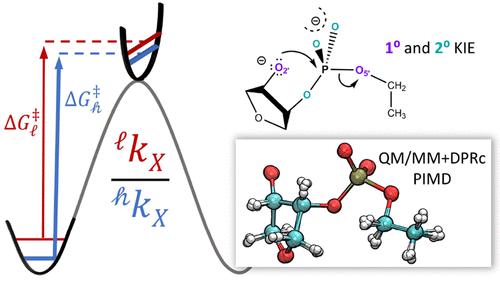当前位置:
X-MOL 学术
›
J. Chem. Theory Comput.
›
论文详情
Our official English website, www.x-mol.net, welcomes your feedback! (Note: you will need to create a separate account there.)
Combined QM/MM, Machine Learning Path Integral Approach to Compute Free Energy Profiles and Kinetic Isotope Effects in RNA Cleavage Reactions
Journal of Chemical Theory and Computation ( IF 5.5 ) Pub Date : 2022-06-16 , DOI: 10.1021/acs.jctc.2c00151 Timothy J Giese 1 , Jinzhe Zeng 1 , Şölen Ekesan 1 , Darrin M York 1
Journal of Chemical Theory and Computation ( IF 5.5 ) Pub Date : 2022-06-16 , DOI: 10.1021/acs.jctc.2c00151 Timothy J Giese 1 , Jinzhe Zeng 1 , Şölen Ekesan 1 , Darrin M York 1
Affiliation

|
We present a fast, accurate, and robust approach for determination of free energy profiles and kinetic isotope effects for RNA 2′-O-transphosphorylation reactions with inclusion of nuclear quantum effects. We apply a deep potential range correction (DPRc) for combined quantum mechanical/molecular mechanical (QM/MM) simulations of reactions in the condensed phase. The method uses the second-order density-functional tight-binding method (DFTB2) as a fast, approximate base QM model. The DPRc model modifies the DFTB2 QM interactions and applies short-range corrections to the QM/MM interactions to reproduce ab initio DFT (PBE0/6-31G*) QM/MM energies and forces. The DPRc thus enables both QM and QM/MM interactions to be tuned to high accuracy, and the QM/MM corrections are designed to smoothly vanish at a specified cutoff boundary (6 Å in the present work). The computational speed-up afforded by the QM/MM+DPRc model enables free energy profiles to be calculated that include rigorous long-range QM/MM interactions under periodic boundary conditions and nuclear quantum effects through a path integral approach using a new interface between the AMBER and i-PI software. The approach is demonstrated through the calculation of free energy profiles of a native RNA cleavage model reaction and reactions involving thio-substitutions, which are important experimental probes of the mechanism. The DFTB2+DPRc QM/MM free energy surfaces agree very closely with the PBE0/6-31G* QM/MM results, and it is vastly superior to the DFTB2 QM/MM surfaces with and without weighted thermodynamic perturbation corrections. 18O and 34S primary kinetic isotope effects are compared, and the influence of nuclear quantum effects on the free energy profiles is examined.
中文翻译:

结合 QM/MM、机器学习路径积分方法来计算 RNA 裂解反应中的自由能分布和动力学同位素效应
我们提出了一种快速、准确且稳健的方法,用于确定包含核量子效应的 RNA 2'-O-转磷酸化反应的自由能谱和动力学同位素效应。我们应用深电位范围校正(DPRc)来对凝聚相反应进行量子力学/分子力学(QM/MM)组合模拟。该方法使用二阶密度泛函紧束缚方法 (DFTB2) 作为快速、近似的基础 QM 模型。DPRc 模型修改了 DFTB2 QM 相互作用,并对 QM/MM 相互作用应用短程校正,以从头开始重现DFT (PBE0/6-31G*) QM/MM 能量和力。因此,DPRc 能够将 QM 和 QM/MM 相互作用调整到高精度,并且 QM/MM 校正被设计为在指定的截止边界(当前工作中为 6 Å)处平滑消失。QM/MM+DPRc 模型提供的计算加速能够计算自由能分布,其中包括周期性边界条件下严格的长程 QM/MM 相互作用和核量子效应,通过路径积分方法使用AMBER 和 i-PI 软件。该方法通过计算天然 RNA 裂解模型反应和涉及硫代取代的反应的自由能曲线来证明,这是该机制的重要实验探针。比较18 O 和34 S 初级动力学同位素效应,并检查核量子效应对自由能分布的影响。
更新日期:2022-06-16
中文翻译:

结合 QM/MM、机器学习路径积分方法来计算 RNA 裂解反应中的自由能分布和动力学同位素效应
我们提出了一种快速、准确且稳健的方法,用于确定包含核量子效应的 RNA 2'-O-转磷酸化反应的自由能谱和动力学同位素效应。我们应用深电位范围校正(DPRc)来对凝聚相反应进行量子力学/分子力学(QM/MM)组合模拟。该方法使用二阶密度泛函紧束缚方法 (DFTB2) 作为快速、近似的基础 QM 模型。DPRc 模型修改了 DFTB2 QM 相互作用,并对 QM/MM 相互作用应用短程校正,以从头开始重现DFT (PBE0/6-31G*) QM/MM 能量和力。因此,DPRc 能够将 QM 和 QM/MM 相互作用调整到高精度,并且 QM/MM 校正被设计为在指定的截止边界(当前工作中为 6 Å)处平滑消失。QM/MM+DPRc 模型提供的计算加速能够计算自由能分布,其中包括周期性边界条件下严格的长程 QM/MM 相互作用和核量子效应,通过路径积分方法使用AMBER 和 i-PI 软件。该方法通过计算天然 RNA 裂解模型反应和涉及硫代取代的反应的自由能曲线来证明,这是该机制的重要实验探针。比较18 O 和34 S 初级动力学同位素效应,并检查核量子效应对自由能分布的影响。



























 京公网安备 11010802027423号
京公网安备 11010802027423号